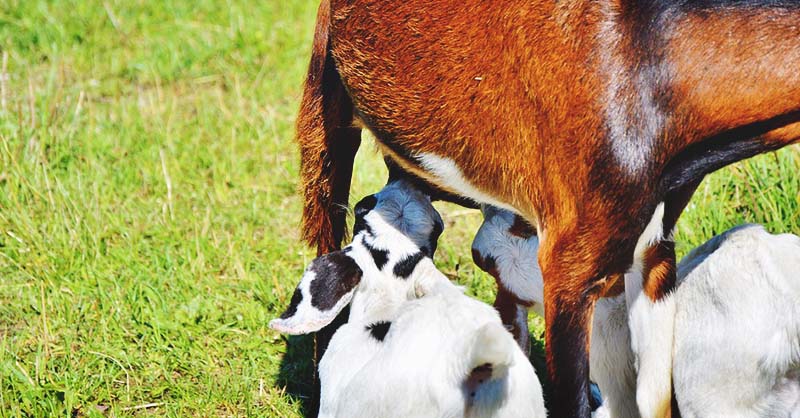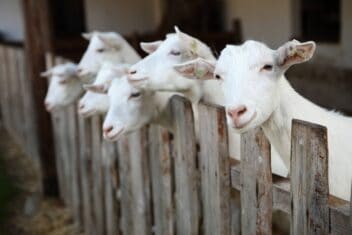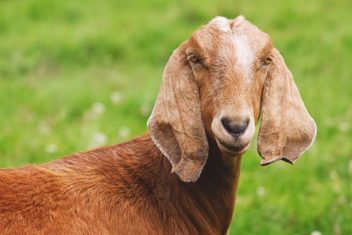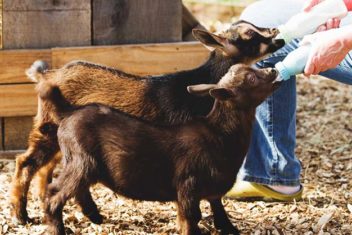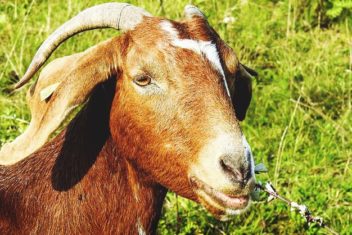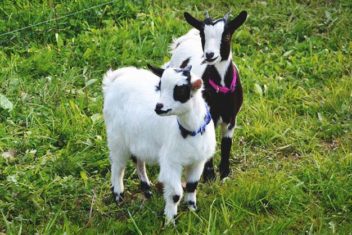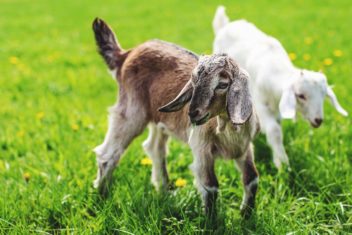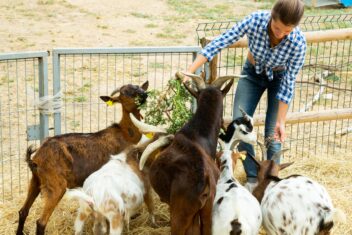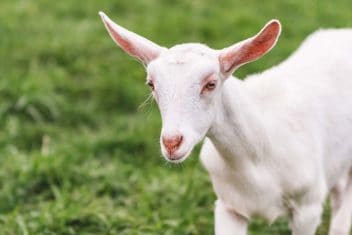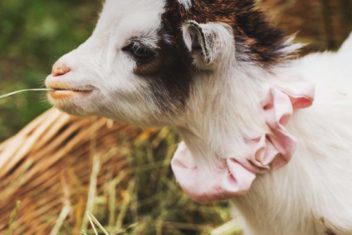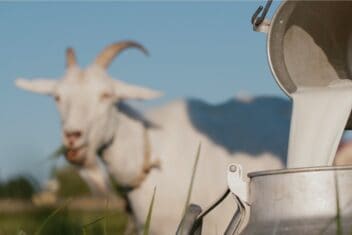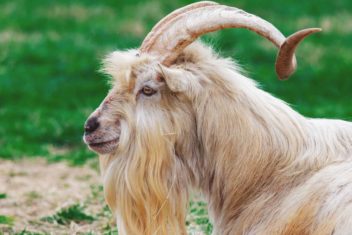Raising goats for milk production is generally considered the most labor-intensive reason for keeping them. Between daily milking, special nutrition management, and the mandatory breeding necessary to maintain milk production, keeping a dairy herd is a big commitment.
If you want to learn about the special details involved in keeping a dairy herd and get some direction on the kind of decisions you’ll need to make for your dairy herd, you’ve come to the right place!
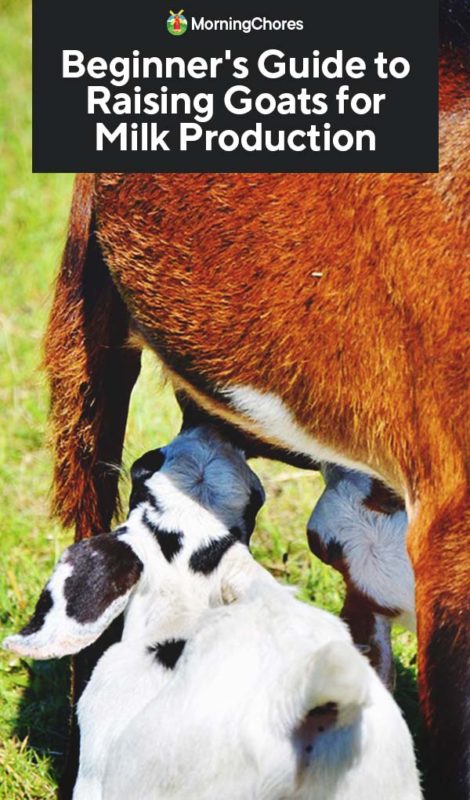
Choose Dairy Breeds
The first thing you need to know is that dairy goats are built differently than your meat or fiber focused goats. Dairy goats have been selectively bred over thousands of generations to make milk rather than store muscle mass.
That means dairy goats tend to have leaner frames and will turn all that pasture they eat into milk rather than meat. So, if you need goats for milk production and excellence and volume is your goal, then you have to stock your herd with dairy breeds.
1. Breeds to Consider
Alpine, American LaMancha, Oberhasli, Nigerian Dwarf, Nubian, Saanen, Sable, and Toggenburg are the primary dairy breeds available in the US. Around the world though, other options include Golden Guernsey, White Russian, the Norwegian milk goat, and more.
Additionally, there are some well-known crosses between the Nigerian Dwarf dairy goats and larger breeds with names mini-Manchas, mini-Nubians, and mini-alpines. These aren’t technically a goat breed. However, they can make for some of the most productive mid-sized dairy goats in a homestead setting.
2. Specifically Bred Goats for Milk Production
Also note, sometimes the mini-breeds like the Nigerian Dwarfs are also bred for use as pets. Those goats may or may not be great milk producers.
For best results, you’ll have to buy from a breeder who is focused on goats for milk production rather than appearance (e.g. blue eyes or particular coloration patterns).
Breeding Management of Goats for Milk Production

Dairy goats must breed, e.g. have babies, to produce milk. So, it’s important to have a plan for how and when you’ll do this to maintain your goats for milk production. Here are a few things you need to know and consider when making your plans.
1. Frequency of Breeding
Depending on the breed of goat you keep, they will need to have kids (goat babies are called “kids”) about every 1-3 years to maintain milk production.
2. When to Breed
Most dairy goats are seasonal breeders. They tend to be fertile in fall and winter and have kids in the spring.
Mini-breeds like the Nigerian Dwarf goats are usually able to breed year-round. Crosses with mini-breeds may sometimes be able to breed year-round. Also, in areas with less seasonal variances some breeds, like the Nubians, might occasionally be fertile year-round.
Goats can only be successfully bred when they are in heat, also called estrus. You’ll have to learn how to spot the signs and have a buck lined up to do the deed with your ladies at the right time of year.
3. Breeding Age
Doelings (female goats) are generally ready to breed at 8-12 months of age. Many goat owners do not attempt to breed doelings until they are at least 80% of their adult weight. So, if a doe must be at least 135 pounds to meet the breed standards, a doeling would need to be at least 110 pounds to be considered fit for breeding.
There is no fixed retirement age for breeding goats. Does can be bred as long as they are in good health and still come into estrus regularly. However, the genetic history, frequency of breeding, and conditions you keep your goat in will determine their useful breeding life.
4. Gestation and Drying Off
Goat pregnancies, also called the gestation period, last between 150-155 days. For the health of the doe and the kids, many dairy goats are given a 2-month break from milking prior to their due date.
5. Buck Taint
Bucks in a full rut may taint the flavor and aroma of milk. For that reason, many dairy goat keepers take does to have conjugal visits with bucks for breeding rather than letting the buck run with the herd.
Feeding Kids and Milk Production
In order to ensure you get the milk production you want, you’ll also need to decide on your policies for feeding and weaning kids. Here are a few things you’ll have to consider.
1. Freshening
Freshening is the term used to describe a goat’s udder becoming full of colostrum and then milk. First-fresheners are goats who are kidding for the first time. Their udders develop over the last month or so of their pregnancy. They will fill completely in the last day or two before labor.
Many goat keepers have noted that does do not reach their full production capacity until their third freshening, or the third time their udder goes from being non-productive to producing milk.
For long-lactating breeds like LaManchas and Nigerian Dwarf Dairy goats, some goat owners will breed their does once a year for 3 years to push them to full production. Then after their third freshening, they will breed only every 2-3 years, or as necessary for good production.
2. Colostrum
Colostrum is produced by a doe just before the kids are born. It has a yellowish color and a taste that does not appeal to humans.
Residual colostrum can taint the milk taste for a few days after a doe kids. As such, generally, the first couple of days worth of milk are always given to the kids and not used for human consumption.
3. Weaning Kids
Commercially, goats are sometimes weaned as early as 2 weeks of age or as soon as their solid food digestive systems become functional. However, for optimal goat health, allowing kids to nurse for at least 8 weeks and preferably longer is advised.
Some goat keepers will even allow doelings they intend to use as part of their dairy herd to nurse for almost a year.
4. Dam Versus Bottle Raised
You will have to choose whether to dam raise (e.g. let your doe nurse her babies) or bottle raise your kids after birth.
– Bottle Raising
One of the big reasons for bottle raising is to pasteurize the milk so you can make sure milk-transmissible diseases don’t get passed to kids. Also, ensuring that you get your share of milk is another big reason.
If you plan to bottle raise, then you’ll need to separate kids at birth and begin bottle feeding immediately. Usually, you also start milking the does twice a day immediately.
Kids generally need to be feed about once every 2-4 hours for the first couple of days; then feedings can be cut back to about every 4 hours with a longer break overnight.
Some commercial goat keepers only feed baby goats 4 times per day after kids are born. Then they cut down to twice a day once kids begin to eat other forms of feed.
– Dam Raising
If you dam raise kids you’ll need to decide how often to let your kids nurse. Some people will let kids spend the day with the does and separate the kids at night. That allows you to collect the milk in the morning. Others will let kids nurse continuously and just take extra milk at each milking interval.
To a certain extent, demand drives quantity with dairy goats. So, letting kids nurse often and milking twice a day will generally increase production more than other methods.
However, you may want a certain amount of that milk each day for your purposes. In that case, separating does from kids for at least 8 hours will help you achieve that goal.
As long as the kids get sufficient milk each day to grow well, how much you take, or how often you take the leftovers are up to you.
Lactation Period
In general, goats reach peak lactation when kids are about 8 weeks old. Then, depending on the breed and the genetics of the goat, lactation can continue for 8 months to about 3 years.
Even in long-lactating does, production will generally decline somewhat between 8-12 months. The amount of decline can vary greatly from about 20-50%.
Feeding for Best Milk Production
Due to their high milk production, when feeding goats your dairy goats need a bit more nutrition management than goats used for meat, as pets, or weed control.
1. Grain
In addition to access to pasture, dairy goats are often given grain mixes with 14-16% protein on the milk stand. For goats recovering from labor, you can give them as much grain as they will eat.
Once their bodies are back in good condition, then a common rule of thumb is to give 1 pound of grain for every 3-5 pounds of milk as needed to help dairy goats maintain peak health.
2. Free Choice Hay
Unless dairy goats are overweight, they are usually allowed free access to hay whenever they are not in pasture. Since dairy goats need more calcium than non-lactating goats, adding legume hay is helpful.
3. Mineral Supplementation
If your dairy goats don’t have access to legumes in a pasture or as hay, then consider using supplements like alfalfa pellets in your grain mix to increase calcium.
Free choice minerals, formulated for dairy goats, are also generally required for optimal health.
The Milk Parlor
Most dairy goat keepers create a separate space for milking their does. This can be a stall in the barn, a separate building, or a covered area outdoors away from the herd. For ease of cleaning, concrete floors are usually recommended.
In a small homestead herd where milk is just used for personal consumption, though, you only need a space that is comfortable for your work year-round.
For example, I partitioned off a part of my goat shed for milking. The area has a table for me to set my milk caddy on. I keep the goats out when not in use so it stays clean. I sweep up goat droppings after my milk is stored in the house so I don’t stir up dust and contaminate my milk by accident.
Dairy Equipment
You do need some special equipment to milk goats.
1. Milking Supplies
Containers to catch and store the milk are needed. Stainless steel is recommended because it is easy to clean. Personally, I use glass and plastic because they are cheaper.
Also, having a method for straining the milk to remove debris like hair is important. Paper or cloth filters can both work well.
If you prefer not to milk by hand, then you may want to get a milk machine. High-quality, easy to clean machines are a bit more expensive than less efficient models.
2. Cleaning Supplies
You will also want to pre-clean your goat’s udder to minimize debris dropping into the milk. Using washcloths with warm soapy water or udder wash is helpful.
You may also want supplies to clean your floor and milk stand as needed. Hoses, buckets, and tools for drying the area can be useful.
3. Product-Related Supplies
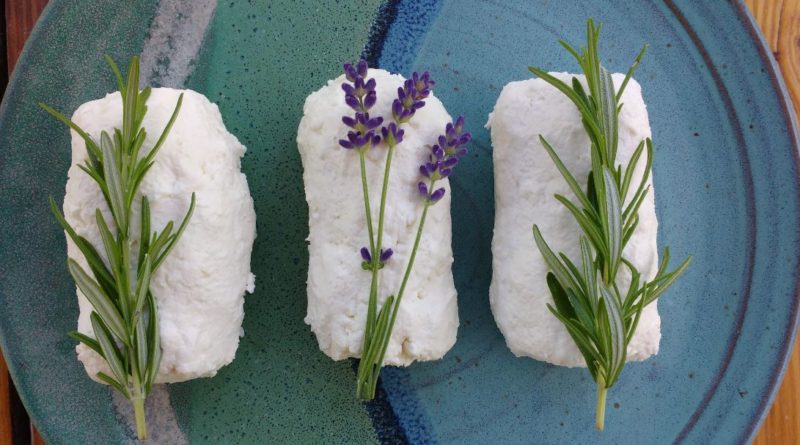
If you plan to pasteurize milk or make cheese or butter, you may also require special equipment for those processes. Molds, kitchen utensils, fat separators, cheese caves, cultures, and more may be needed.
4. Milk Stand
Finally, a milk stand is a must. It elevates goats to a height more comfortable for you to work at. Plus it’s a useful tool to ensure you don’t lose milk to goat-related accidents or bad behavior.
Training Dairy Goats
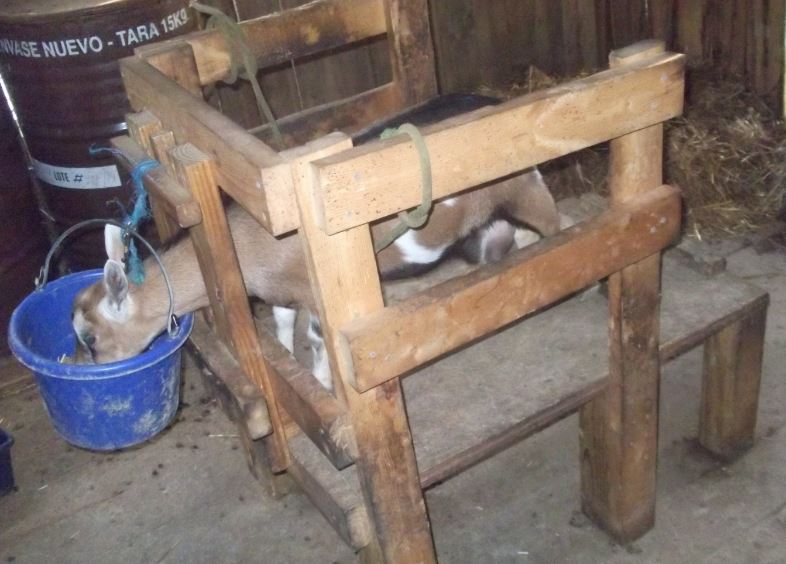
No goat is born knowing how to be a good dairy goat. A goat’s natural instinct is to kick you off when you try to take their milk. So, you will need to train your goats to tolerate being milked.
1. Udderly Comfortable
It helps to begin handling your goat’s udder long before they have their first freshening. This way they are already acclimated to your touch when you begin to milk them.
2. Milk Stand Training
It also helps to get goats used to eating from and being trapped on the milk stand before you ever try to milk them. Make them feel at home on the stand for the best results.
Safe Milking Procedures
There are a few easy ways to help ensure the safety of your goat’s milk for your family. Using clean equipment to milk and washing the udder and belly area before milking, is a good starting point.
1. Refrigeration
Making sure milk is refrigerated as quickly as possible will reduce the risk for pathogens to propagate in your milk. Milk should be strained and refrigerated or otherwise processed within 2 hours of milking (preferably a lot sooner).
2. Pasteurization
Although many goat keepers, myself included, routinely drink raw milk with no problems, pasteurized milk is considered to be safer than raw milk. Particularly for children and adults with compromised immune systems, pasteurization is strongly encouraged by the US Food and Drug Administration.
Dairy Goat Health Problems
Dairy goats are generally subject to the same health risks as any other goats. However, because they lactate longer, kid frequently, and are milked, they are at greater risk for mastitis.
1. Mastitis
Mastitis is an inflammation of the mammary glands. It is often caused by bacteria, but may also be viral. Mastitis negatively impacts milk production, and it may also lead to a permanent reduction in milk capacity if left untreated.
Paying close attention to udder health, being alert to teat sensitivity, and responding and diagnosing the kind of mastitis quickly is key to controlling this potentially detrimental condition.
Ensuring that your equipment is clean, particularly if using a milk machine, and using gentle products and processes to clean the udder are also critical.
2. Mineral Deficiencies
Dairy goats may also be more susceptible to complications from mineral deficiency. Copper and selenium deficiency, in particular, can impact fertility and lead to reductions in milk production.
Talk to your veterinarian about which deficiencies are common in your area and how to treat them.
Conclusion
There’s a lot more to learn about keeping a dairy herd than I can cover in this beginner’s guide. However hopefully, this overview will help you be mentally prepared as you start your journey with dairy goats.
Make sure to check out all our other great resources to help you choose breeds, manage pasture, and more for happy and healthy dairy goats!
